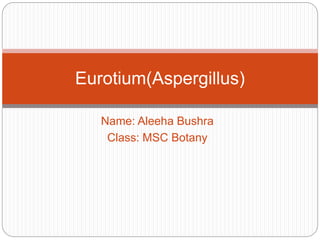
Eurotium(aspergillus)
- 1. Name: Aleeha Bushra Class: MSC Botany Eurotium(Aspergillus)
- 2. Eurotium Systematic position Kingdom Fungi Division Ascomycota Class Eurotiomycetes Order Eurotiales Family Trichocomaceae Genus Eurotium Species Eurotium amstelodami
- 3. Habitat They are commonly found as filamentous mouldy growth on the surface of damp fruits and vegetables preserved fruits, moist breads, jams and various conserves, and also on imperfectly dried herbarium specimens. Many species are commercially important on account of their hydrolysing powers on starch and sugars and cause fermentation to citric and oxalic and rarely to alcohol. Most of the species of Eurotium are saprophytes and occur on a wide variety of organic substrata. A few species are parasites and cause diseases of the skin, ear and respiratory organs of higher animals including man. The generic name Aspergillus was given to the conidial stage of the fungus long ascospores were found, and this name still survives in the name of the family
- 5. Vegetative Structure The vegetative body is a much-branched mycelium consisting of usually colourless, septate hyphae. It ramifies in or on the surface of the substratum, or through the intercellular space of the host tissue. Each hyphal cell contains granulate, vacuolated and multinucleate protoplasm with oil globules as food reserves. I t contain stipe, foot cells, sterigma which contain conidia.
- 7. Reproduction Eurotium reproduce by Asexual reproduction Sexual reproduction
- 8. Asexual Reproduction . During asexual reproduction numerous straight, thick-walled, aseptate and upright hyphae shoot up in the air. These are called conidiophores. The free end of each conidiophore swells up and usually becomes spherical forming a vesicle. This vesicle buds out a large number of peg-like outgrowths, called sterigmata. From the tip of each sterigma spherical or nearly spherical, smooth or roughened conidia are cut off in basepetal succession, the youngest conida remain in contact with the sterigmata, while the oldest ones are farthest away from them. The cytoplasm and nuclei stream up the conidiophore into the sterigmata and finally into the developing conidia. The number of nuclei in each conidium is variable and it varies from species to species. Usually, it is multinucleate, but some rare cases there may be one nucleus in each conidium. The conidia, as they are formed, are not separated from one another for the time being, but they remain in rows or chains on the sterigmata till they become ripe. They are produced in enormous quantities and at maturity become deciduous, and are readily carried away by the wind. Each conidium, under favourable conditions, germinates on a suitable substratum and produces a mycelium directly.
- 9. Sexual Reproduction Sexual reproduction of Eurotium will be described here for the best known species E. herbariorum (= Aspergillus herbariorum). In the species the same mycelium, producing the conidia, eventually bears the sex organs. The female branch, or the archicarp, is a specialized hypha, which becomes coiled, at first loosely but later on very closely, in a helix. This archicarp, at first one-celled, is soon divided into several multinucleate cells. At this stage, it becomes differentiated into three portions- a multicellular stalk, a unicellular oogonium, and a terminal unicellular trichogyne. After the differentiation of the archicarp, there appears another septate hypha, from the tip of which the unicellular, multinucleate antheridium is cut off. The antheridium develops either independently of the archicarp on another hypha, or is formed on slender branches arising from beneath the archicarp. After its formation, the antheridium appears to climb up the side of the coiled archicarp. The union between the antheridium and the archicarp has not been observed in any case and possibly does not take place. The antheridium appears to be rudimentary and its nuclei usually degenerate before it attains the full size. The growth of the antheridium may even be checked, or the antheridium may not develop at all.
- 10. Continue…. However, the oogonium soon becomes septate and forms binucleate cells. From these binucleate cells small outgrowths develop, which grow and form branched hyphae, the ascogenous hyphae. From the terminal or sub- terminal cell of an ascogenous hypha an ascus develops. When young, each ascus is binucleate. The two nuclei fuse to form a fusion nucleus. It undergoes three divisions, in one of which reduction in chromosome number takes place, forming eight daughter nuclei, around which ascospores are delimited. The cytoplasm, which is not used up in the formation of ascospores, constitutes the epiplasm containing food substances, especially glycogen. Each ascospore has a sculptured spore wall (epispore) and is of characteristic form, and when seen laterally, somewhat resembles a pulley wheel or a butcher’s tray.
- 11. Continue….. A little before the septation of the oogonium some vegetative hyphae grow up and cover the sex organs. The hyphae by inter- weaving and septation form a thick outer wall of small-celled pseudo-parenchyma which completely encloses the sex organs. Some of the hyphae grow inwards and form a nutritive tissue around the sex organ. The entire structure, thus formed, is the fructification of Eurotium and is termed a cleistothecium. The wall of the cleistothecium becomes invested with a brittle- yellow substance. At maturity, the ascogenous hyphae, the cells of the nutritive tissue and the walls of the asci disintegrate and are ultimately absorbed, so that the ascospores lie free within the outer brittle pseudoparenchymatous sheath of the cleistothecium. This wall finally decays and the ascospores are set free. Each asccspore, under favourable conditions, germinates on a suitable substratum and produces a new mycelium.
- 12. Life cycle